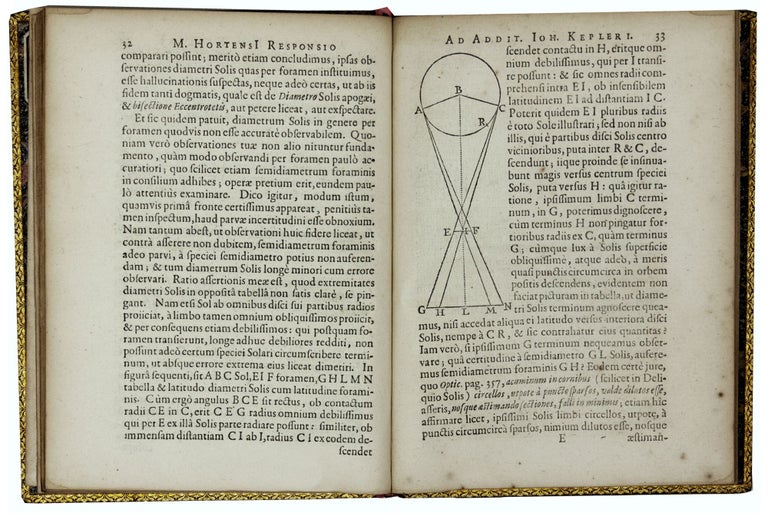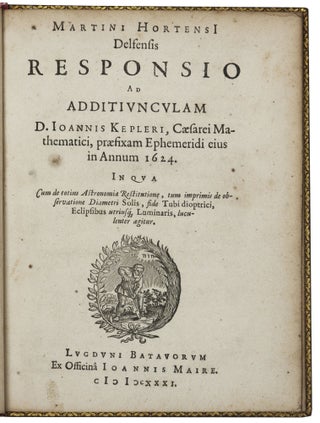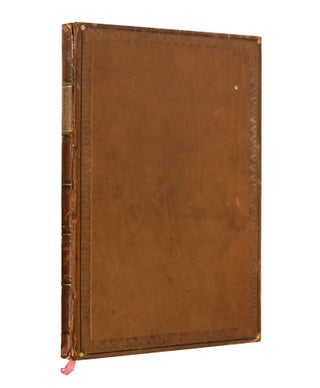Martini Hortensi Delfensis Responsio ad Additiunculam D. Ioannis Kepleri, Caesari Mathematici, praefixam ephimeridi eius annum 1624.
4to [18.3 x 13.8 cm], (4) ff., 54 pp., (1) f., woodcut printer’s device, initials, and diagrams in text. Bound in nineteenth-century calf, blind-tooled borders, gilt dentelles, all edges gilt, joints tender but sound. Some minor marginal browning and spotting, generally excellent. Very rare first edition of a treatise by the Dutch autodidact astronomer Martin Hortensius (or van den Hove) (1605-39) refuting Johannes Kepler’s (1571-30) criticism of his measurements concerning the angular diameter of the sun. The two men first disputed this observational problem following Hortensius’ publication of his findings in the preface to Philippe van Lansberge’s (1561-1632) Commentationes (1630), with Kepler responding in his 1630 Ephemerides. In the present work, the Responsio ad Additiunculam D. Ioannis Kepleri, Hortensius presents evidence he gathered using his dioptric telescope and in observing eclipses. Ascertaining the size of the sun (angular diameter) was an urgent requirement in refining Kepler’s groundbreaking planetary theories: “This question was of great importance, because it was directly connected to the matter of the eccentricity of the earth’s orbit, which Kepler had investigated by using observations of Mars. Kepler was vehement regarding this issue and used untenable arguments; Hortensius responded politely but suggested that Kepler might have altered the observational results to get agreement” (DSB). Hortensius thus here both advances Kepler’s theories of planetary motion and vindicates the use of optical telescopes in observational astronomy of this sort (Kepler, every wary of optical aberrations in the use of lenses, made these observations with a pin-hole tube). Called “Galileo’s Dutch sympathizer” (Koester and Bergmans, p. 356), Hortensius was “the first university professor who openly professed the motion of the earth” (Bonner, p. 146), becoming in 1634 “the first Copernican to be appointed to a chair at a Dutch University” (Brown, p. 24). Hortensius first studied mathematics with Beeckman and Snell, later collaborating with Philip van Lansberge, whose works he translated into Latin. Hortensius was critical not only of Kepler, but also the Danish scientist Tycho Brahe in his work. He corresponded with Descartes, Mersenne, Gassendi, Huygens, and Galileo, and in 1638 was on the commission to work with Galileo on a method of determining longitude by observation of the position of Jupiter’s satellites. He died at 34 years old. OCLC: one U.S. copy, at the University of Texas. No copies at auction listed. *Hoogendoorn, Bibliography of the Exact Sciences in the Low Countries from ca. 1470 to the Golden Age (2018), Hort Mo2; Caspar 84n (p 95); DSB, vols. 5 & 6, p. 520; J. Brown, New Heavens and a New Earth: The Jewish Reception of Copernican Thought; P. Bonner, Change and Continuity in Early Modern Cosmology; T. Koester and L. Bergmans, eds., Mathematics and the Divine: A Historical Study; C. de Waard, “Hortensius,” Nieuw Nederlandsch biografisch Woordenboek, 1, (Leiden, 1911), cols. 1160-4; Robert McKeon, “Le debuts de l’astronomie de precision,” Physis, 13 (1971), pp. 225-88 and 14 (1972), pp. 221-42, especially 13, p. 230; A. Van Helden, Measuring the Universe: Cosmic Dimensions from Aristarchus to Halley, (Chicago: U. Chicago Press, 1986), p. 104.
Sold



